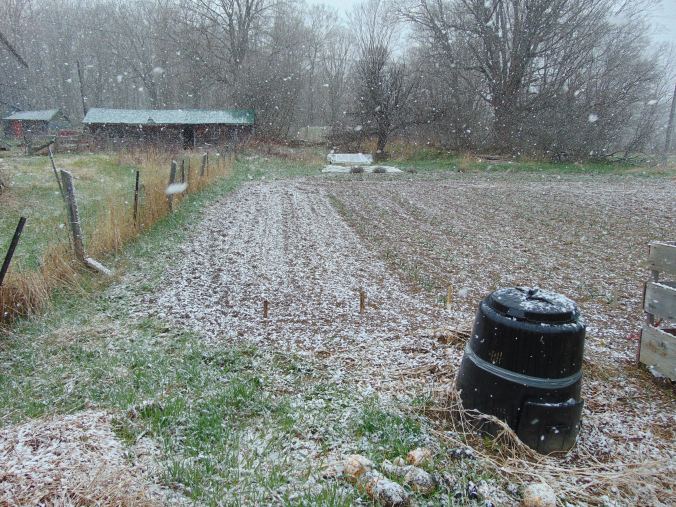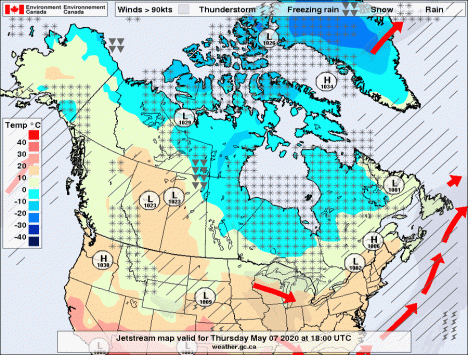
There’s snow peas in there somewhere, under the snow.
What’s with the weather?
Here in southern Ontario, Canada, in The Great Lakes region of North America, as we approach mid-May, to say the weather in ‘unseasonable,’ is to put it mildly.
No sooner is that word out of my fingertips and on the cyber-page than it seems incongruous in the circumstances: it’s anything but mild outside. It’s cold, and wintry cold at that, with sub-zero, night temperatures in the seven-day Environment Canada forecast.
I look out my kitchen window, just now, and see big, fat flakes of snow falling steadily just before 11 a.m.
This is not a good thing for farmers and market gardeners looking to get their tender summer crops in the ground, or still waiting for earlier, more-temperature-hardy crops already planted to emerge. Like — and I shudder to confess this — the well-sprouted seed potatoes I planted in early April after a few days of unseasonable warmth. Still not up. But there’s the rub after all: you can hardly predict the weather anymore.
And you thousands of people suddenly interested in growing your own food for perhaps the first time, or perhaps returning to it after many years – what about you? It’s May, right? You waited patiently for the seeds you ordered on-line to arrive, or you went to the local nursery looking for seeds and/or starter plants. But you found out the seed companies were overwhelmed with an “unprecedented” demand in response to the Covid 19 crisis. So, you’re still waiting for your order, or it took an awful long time to arrive; or some seeds were already sold out.
Don’t worry too much. On the bright side, you’ve still got time.
Ideally, you ask, aren’t you supposed to start planting those seeds and setting those transplants on or about the May 24 holiday weekend; or at least no later than the end of the month?
No, not at this rate, not with winter-like temperatures preventing the soil from warming up sufficiently. For, above all, soil temperature is the most essential factor in successful gardening. Even ‘snow peas’ – though there’s a reason they’re called that — will struggle to germinate and emerge if the soil temperature is less than 10 degrees Celsius. Which reminds me of another essential of successful gardening: read the directions on the back of the seed packet or container.
Climatologists, meteorologists, and data-processing experts are still trying to figure out why in this period of global warming and climate change the seasons have become, well, so unseasonable.
Something called the dreaded “polar vortex” has entered the lexicon of everyday conversation. And why does it appear to have a particular affinity for The Great Lakes region, showing up unwelcome, and refusing to go back home up north, lingering over us for days if not weeks on end, and generally being a pain in the butt?
The experts — bless their barely-readable, virtually-inaccessible (to most of us) journal-published, study reports – are pretty sure it has something to do with the climate-change disruption of high-altitude winds in northern latitudes, including the Jet Stream, and the even-farther-north Polar Vortex itself. The data shows a coincidental connection with the fact the Arctic region has been warming relatively faster than tropical and sub-tropical regions much further south. Which doesn’t mean it’s not cold up there. It’s just that, by now, it should be up there and not down here.

Environment Canada Jet Stream map, May 7, 2020. Note central Alaska
“The cold is very unusual,” said Ryan Maue, a meteorologist quoted in an article published this week on-line by CNBC.
Much of the north-east U.S. is facing similar unseasonable cold weather. Weather-forecast broadcasts abound world-wide, but they routinely lack in-depth explanation of what causes the weather.
“It is difficult to pinpoint the cause-and-effect or correlation-causation with extreme weather events and climate change,” Maue said. “But changes in the behavior of the jet stream are becoming more accepted by scientists looking for physical reasoning behind what we are seeing on weather maps.”
He called what we’re going through, “not just some random one-off weather event but an obvious trend toward hyper-extreme atmospheric circulations outside the normal bounds of what we typically experience in May. It’s not always hotter and dryer with rapid climate change, but also colder and wetter.”
I don’t take the continuing scientific uncertainty as an excuse to justify global warming- climate change denial. I believe the experts are on the right track; and this more than likely is the ‘new normal.’
As for you and me, as farmers, gardeners, and concerned people, we should take necessary precautions now to adapt.
If you’re like me and prefer to use untreated seed, that is, seed not treated with fungicide to prevent it from rotting in soil to cool for germination, then planting is not about the date. It’s about soil temperature. I have been too eager to plant often enough myself to have learned that lesson, especially when it comes to my favorite summer crop, sweet corn. The soil must be at a minimum, 21 degrees Celsius, or 70 degrees Fahrenheit.
Again, read the directions on the back of the seed packet for recommended soil temperatures for other crops.
Don’t take chances. Buy a soil thermometer. Keep a daily eye on the seven-day forecast. Wait for the weather, and the soil, to warm up consistently. It may be early June by then. Don’t worry, be happy — your garden will jump with joy when it happens.
Good advice. I’ve been telling newbie gardeners in our area “it’s the temperature, not the date” for weeks now, but some of them planted their tomatoes and peppers anyway. Now we have 29 degrees F and snow in the forecast for tomorrow night!
LikeLike
They’ll learn, Carolee. The urge to get seeds or plants in the g round and watch them grow is a powerful one. But patience is also the mark of good gardening. Thanks for your comment.
LikeLike
Phil, I’m reposting these gardening essays on my Facebook Page, because I know gardeners out there who would like to read them, and because someday, I want to be a gardener myself. As it is now, I’ve never planted a plant in my life. Shocking, isn’t it? But I have finally gathered together the beginnings of a decent little kitchen garden of herbs and I am focusing on keeping them alive. One has to start somewhere. I always enjoy your perspective, such an elegant mix of down to earth detail, literally, and the very big and deep picture! Good luck, and I look forward to your updates.
LikeLike
Thank you, Gail, for the compliments. No, it’s not that ‘shocking.’ There was a time when most Canadians were born and raised on a farm. And even when they moved on to the city to find their dream, the farm connection was in their hearts. I always look back on my farm experience as a boy as a blessing, despite the circumstances. And even as a teenage city-kid I wanted to get back to the land. So here I am, 40 years in Hope Ness, and don’t ever want to be anywhere else. Oh, well, a trip to Greece would be nice. That’s in my blood too, I think. However humble your beginnings are as a gardener now, I think you’ll find it will grow on you, pun intended. It has so much to offer, this included, as my grown-up grandson discovered one day last summer when he helped me plant a few rows of corn: he stopped, looked over at me and said, “You don’t think of anything else when you do this do you?” I said, “yes, Daniel, that’s so true; it does focus the mind in a comforting sort of way. And that’s a very insightful observation on your part.” Stay well, Gail.
LikeLike